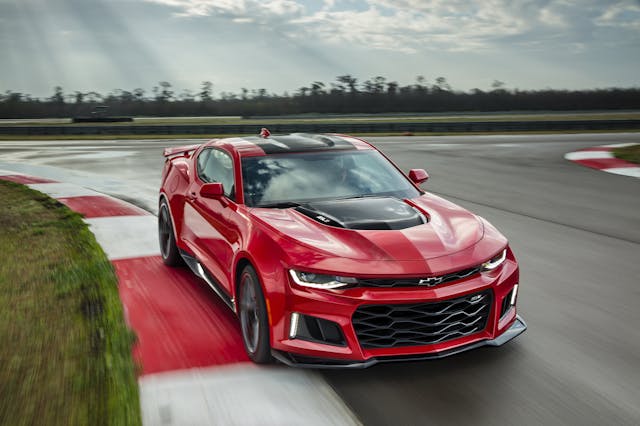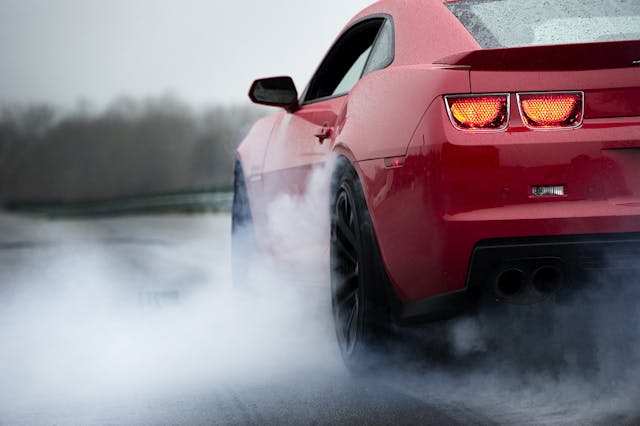Media | Articles
The Camaro ZL1 Was a Rule Breaker from Day 1
There are lots of rules that automakers have to play by, and they’re imposed from a lot of different places. A few even come from inside the house, and those who know their automotive history are well aware that the people and projects that broke those internal rules are often fodder for some of the most interesting tales. John Delorean and the team behind the Pontiac GTO was an experiment in loopholes that led to an industry-defining success, but there’s another side of that coin. Other cars pushed the envelope a little too much, and amazing though they were, rules and hierarchy meant they were destined for a short run. Case in point: The Camaro ZL1.
The Corvette has long been General Motors’ darling, and there’s a long-known unspoken edict that America’s sports car is the top dog in GM’s portfolio. This has kept other models from reaching their full potential, and we consumers are worse for it. Luckily, some people believe rules are meant to be broken. After some clever selections on a GM order form in the late 1960s, a Camaro was able to eclipse the Corvette, if briefly. Unfortunately, it was difficult to hide something that shone so bright, and consequences soon followed.
The Camaro ZL1 model gets its name from the aluminum 427-cubic inch engine Chevrolet developed for use in Can-Am racing in the 1960s. To say that series’ rulebook was loose would be an understatement, and that meant big horsepower from big cubic inch engines. The street ZL-1 pulled a lot from the Can-Am spec engine, but opted for wet sump oiling, a mechanical fuel pump, and a few other items that gave a collective nod to longevity. It wasn’t a road racer who managed to get this hard hitting big-block into a production car though. In fact, it wasn’t even someone who worked for GM.


Instead, it was Chevrolet dealer Fred Gibb. The businessman and drag racer saw the quarter-mile potential in this aluminum power plant, but he was hamstrung by the Stock Eliminator rulebook requiring 50 production cars to qualify his parts-bin racer. He was also up against GM’s rule against engines larger than 400 cubic inches going into anything other than Corvette, trucks, or big sedans. Gibb wasn’t going to give up that easy though, especially when there was a loophole waiting to be exploited.
The Central Office Production Order (COPO) system was designed for dealers to be able to order special fleet vehicles. This was intended to fill orders like municipalities in need of police cars, or other fleets that had specific requirements for their vehicles. Gibb leveraged it to order the 50 cars needed to meet the American Hot Rod Association’s rulebook requirement, and suddenly Chevrolet rolled out a fleet of Camaros that broke its own rules. In drag racing trim it was a solid 10-second car thanks to the underrated 430-horsepower aluminum big block and additional weight savings from leaving off anything not necessary to go fast.
Marketplace
Buy and sell classics with confidence

The story would have been awesome enough if it ended there, but of course there was more. The COPO ZL1 Camaros were expensive, and Gibb was forced to negotiate with GM to return over three dozen, some of which were stolen and stripped while in shipping. The idea was solid, though, even if the first attempt struggled. Before GM could wise up and close the loophole, another dealer stepped up and started sending in orders for a slightly revised COPO order. This time it was Don Yenko, and his approach was milder, if only slightly. Instead of the expensive all-aluminum ZL1 engine, his order sheet specced an L72 iron-block 427. It still broke GM’s rules, and it was similarly short-lived, but the side-door sleight of hand has become the stuff of legend in Chevy circles.

As a result, history would not forget the Camaro that could have been. The ZL1 name has been revived multiple times over the years in a fascinating nod back to a car that Chevrolet itself tried to keep from ever seeing daylight. Turns out that sometimes it takes someone outside the corporate office to see what could be, and if they can manage to make it happen, corporate sometimes doesn’t have a choice but to take note.
***
Check out the Hagerty Media homepage so you don’t miss a single story, or better yet, bookmark it. To get our best stories delivered right to your inbox, subscribe to our newsletters.








You must recall most of the racing GM did ir assisted with was all done hidden or lied about due to GM rules and agreement not to race in the early 6o’s.
Chevrolet Racing? By Paul Van Valkenburg. This book is a fascinating look at Chevy working with a number of race teams and sone of the cars and options that came from it. Jim Hall and Roger Penske got most of the help but many others worked to help GM under cover. Smokey Yunick, Jounior Johnson and others.
The tech GM offered brought many changes to racing though they were not very public about it. Thjngs like the Chaparral high wings and sucker car. Can Am teams and the Z/28 all brought some amazing things.
ZR1 was just one more example of what hey could do. I could only imagine if they were freed up.
My cousin had 71.. with a Hurst slap stick with a 3000 stall converter 4/11 gear and that that car was also very reliable.. he’s had it for about 30 years and still runs like a wounded ape .. they should have never stopped making the 302
Had a 71
People never talk about the z28 with the wicked 302, 4 sp. Why, it was a sleeper.
My parents had one. I would borrow on Sat nite, head downtown Sac, to race everyone. A friend had 64 Ford Galaxies who walked all over me. He had 427. We went out to El Centro Rd to race. I had best life. My dad was my hero, he would go with, make sure l didn’t end up in jail.
Oh, I’ve always heard plenty about Z/28s. A clever “parts bin” motor built to satisfy race rules and put in cars that sold tens of thousands. Always more accessible than the mythical ZL1.
To the writer, you forgot Berger Chevrolet and the COPO’s they sold.
I never understood why Chevrolet didn’t offer the 350 HP or the 365 HP 327’s (available in the Corvette) in the Camaro. Both these engines were good performers, didn’t carry the weight penalty of a big block, and got around the GM 400 cubic inch edict. I owned an L30/M21 Camaro (67) for years, and an extra 50 or 80 HP from the factory would have resulted in a very quick, well balanced car.
A question came to me after I posted last comment. I noticed when most COPO Camaros come up for sale, they have the dog dish hubcaps. Does this mean these cars were ordered without front disc brakes (which would have included rally wheels )? I seem to recall drums supposedly offered less rolling resistance in a drag race, maybe that explains it. Any Camaro Historian out there with the answer?
rally wheels were an option that had to be ordered. I bought a 1969 SS- RS new that came with dog dish hubcaps and it had front disc brakes standard because it was an SS
Interesting, I ordered my ’67 with front disc brakes (J52), rally wheels were included with that option. (I still have the order sheet). Must have changed after 1967. Learn something every day.
A friend of mine special ordered a 1972 Mustang with drum brakes for that reason
I owned a ’69 Camaro in 1971. Even though it was a Z/Nothing, I loved that car!
I think the death of the Camaro is a sad thing but the last two generations were to me hard to live with on a daily basis with their I’m sitting in a bunker high beltline. On a track they are just fun! The last restyling did not help sales either. In this case the Mustang did a better job to be an everyday car.
Drag racers prefer (or at least they used to, I’ve been out of that scene for decades now) because they’re significantly lighter than disc setups. Perform significantly poorer too – I vividly remember having to let the air slow the car to 70MPH after the traps before using any brakes. Slowing hard from 70 to 15 overheated them to useless just in time to make the last turnout at New England Dragway.
…”prefer drums”….
A friend of mine bought a 1969 Z/28 off the show room floor. It was odd that it had a silver exterior with red stripes but had a burgundy interior. The red stripes on the hood clashed @ the dashboard & clashed with the burgundy @ the rear deck. Maybe it was an early car and the only one the dealer could get at the time.
The one thing that I do not hear discussed is the chamber exhaust they punt on those hi revving 302’s what a great sound that was. I’d love to hear some comments regarding that exhaust system.
Most of the Z28’s that I see in car mags don’t have the cross Ram manifold. Wasn’t the cross ram intake standard on a Z28 ? When I see a supposed Z28 without one I am dubious.
The cross ram was an in the trunk option to be installed by the dealer